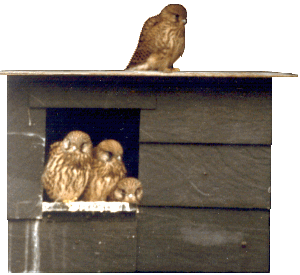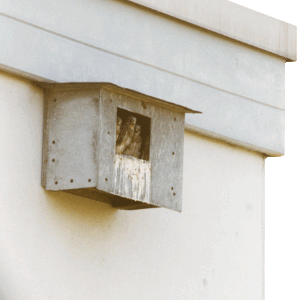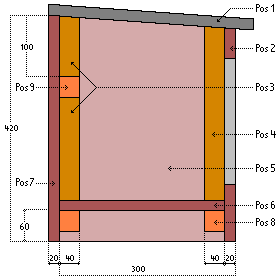| Home |
Rolf Hölterhoff |
Solingen |

Kestrelís nesting boxes
You will find the construction drawing of kestrel nesting boxes below;
they proved most successful in my area. "Blown up" in proportion the boxes
may also be used for peregrines (Falco peregrinus).
Very important: The bottom of the finished box must have some
drill-holes up to some 4 mm in diameter to drain it in case of heavy
rainfall; and it must be covered in wood chips and shavings, peat
etc. (e.g. material as available for bird-cages in pet shops).
The female kestrel has to be in a position to scratch a nesting
hollow for her eggs. Without nesting material all efforts are in vain:
the box will never be occupied!
The nesting box should be made out of waterproof chipboard about
20 mm thick or boards screwed onto a framework of sturdy square battens
and impregnated against dampness and infestation with pests. The
impregnation might also work against feather parasites (mites, lice).
For safety reasons all screws (or bolts and nuts) should be in stainless
steel or brass (with the stainless steel likely to prove more durable than brass).

The roof should be protected with the best bituminous roofing for
flat roofs available from a roofer's shop. The outer walls can be fitted
with various plates according to visual demands. We have used the
above-mentioned bituminous roofing, natural slates, stainless steel,
Eternit, aluminium or copper plates. It goes without saying that
the plates should either be soldered together (to effect waterproof seams)
or overlap and the gaps sealed with silicone (which, unexposed to sunlight
under the plates, will not be destroyed by UV-radiation). The cladding
projects below the walls by approx. 2 cm. For mounting long stainless steel
hexagon head wood screws of 10 or 12 mm in diameter proved themselves when
fastened in corresponding plugs in the stones (not seams) of the walls of buildings.
To check the stability a crew member used to hang on to the boxes,
which never moved a millimeter. The boxes should be mounted on the east
or south wall of a building to avoid squalls and heavy rain during our
prevailing west wind.
The less exposed and the more sheltered a box is mounted (e.g.
right next to a down pipe or beneath the gutter), the more likely
it is to be occupied. Traffic noise and the peal of bells seems to
be readily accepted by kestrels, but they are sensitive to human
disturbance beneath a box hanging too low, which may even result
in the box not getting occupied.
 |
|
| Pos. |
Description |
Measures in mm |
Units |
| 1 |
Roof |
20 x 370 x 640 |
1 |
| 2 |
Front*) |
20 x 400 x 600 |
1 |
| 3 |
scantling |
40 x 40 x 340 |
2 |
| 4 |
scantlings |
40 x 40 x 320 |
2 |
| 5 |
Side-wall |
20 x 310 x 420 |
2 |
| 6 |
Bottom |
20 x 300 x 510 |
1 |
| 7 |
Rear side |
20 x 420 x 550 |
1 |
| 8 |
scantlings |
40 x 40 x 550 |
2 |
| 9 |
scantlings |
40 x 40 x 470 |
1 |
| *)Entrance: shiftet to the left side in the upper half of the front wall approx. 25 x 25 cm |
|


